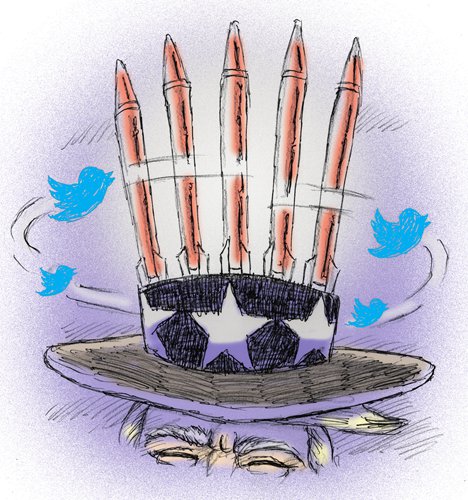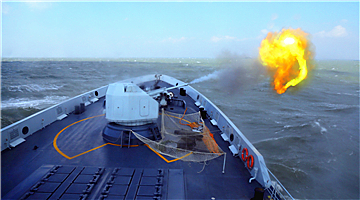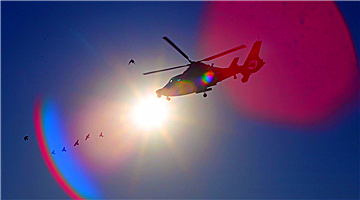
By Guo Xiaobing
The US' nuclear weapons arsenal has come under much scrutiny recently. The first big news story was that US lawmakers are attempting to restrain the president's authority to wage nuclear war. At a Senate Foreign Relations Committee hearing in November, lawmakers expressed their concerns over US President Donald Trump's sole authority to launch nuclear weapons. "Donald Trump can launch nuclear codes just as easily as he can use his Twitter account without a check and balance," one Senator remarked.
Then a few days ago, a Huffington Post exclusive revealed the contents of the Trump administration's Nuclear Posture Review, not due out until February. The draft signals a farewell to former president Barack Obama's push toward a "world without nuclear weapons," and calls for an increase to the US' nuclear capability.
Just as Trump is extremely sensitive to such charges as "mental instability," the administration does not want his Nuclear Posture Review to be labeled as a return to a "nuclear war-fighting" stance and rejects that it is "reducing the nuclear threshold." The draft tries to dismiss these accusations preemptively, but unfortunately, from the perspective of a researcher who has been following nuclear arms issues for almost two decades, these labels turn out to be true.
Nuclear war-fighting is a negative term in the area of nuclear arms control. The public tends to regard a nuclear war-fighting doctrine as a strategy to win a nuclear war. It is closely related to the US-Soviet nuclear arms race during the Cold War and comes with images of crazy nuclear warmongers. It is understandable that the Trump administration does not like this label. But the logic and measures initiated by the Trump nuclear doctrine fit perfectly into the definition of a nuclear war-fighting doctrine.
The US sees two main arguments in favor of a nuclear war-fighting doctrine. First, the US needs a flexible nuclear force to address a limited nuclear war. Second, the US should develop a strategic defense capability to limit the damage if its deterrence fails.
Statements from the draft report and other official US documents suggest that for a limited nuclear war, the US should expand its flexible nuclear options and develop more low-yield nuclear bombs to address limited nuclear use.
As for the development of strategic defense, the National Security Strategy released in December is committed to developing an enhanced missile defense system, and publicly admits the US will develop the ability to defeat missile threats prior to launch, which is supposed to include cyber attacks and boost-phase interceptions.
The Trump nuclear doctrine has significantly adjusted the US nuclear weapons declaratory policy to loosen the use of nuclear weapons. Nuclear weapons will be used to deter not only nuclear attacks, but also significant non-nuclear strategic attacks. That means the US might use nuclear weapons to retaliate against space or cyber attacks on its infrastructure or the NC3 (nuclear command, control and communication) system.
This adjustment is quite dangerous because there are numerous state and non-state actors active in the space and cyberspace domains. Interactions among these actors are very complex and hard to regulate. Guided by the new declaratory policy of the Trump administration, miscalculation and miscommunication in the space and cyber domains might lead to nuclear disasters.
Furthermore, expansion of the US tactical nuclear arsenal will make use of nuclear weapons much more likely, especially in the use of non-strategic nuclear weapons in regional conflicts. Yet there are no effective mechanisms to prevent regional nuclear conflicts from escalating into large-scale nuclear exchanges.
While the 2010 Nuclear Posture Review promises to promote strategic stability with Russia and China, the Trump nuclear doctrine lays more emphasis on great power competition. The draft report states the US does not wish to regard either Russia or China as an adversary and seeks stable relations with both. But it devotes a lot of space to describing its tailored deterrence strategy against Russia and China. It discusses in detail how to outmatch Russia and China at any level of escalation.
Besides, the Trump administration does not show any passion for maintaining and strengthening the international nuclear arms control regime. It will not seek Senate ratification of the Comprehensive Nuclear-Test-Ban Treaty. It implies that the US might withdraw from the Intermediate-Range Nuclear Forces Treaty, and mentions nothing about a further nuclear disarmament agreement with Russia.
Despite Trump's boasts of being "a very stable genius," it seems he has failed to convince some US lawmakers. Likewise, although the Trump nuclear doctrine argues that more flexible nuclear options in the hands of a benign hegemony like the US will help reduce rather than increase the risk of nuclear war, it will fail to convince the world.
As the only superpower with the strongest nuclear and non-nuclear forces, the US under Trump believes that its nuclear forces are not sufficient, and more efforts should be made to turn the nuclear triad into a more "modern, flexible and resilient" force, so other countries lagging behind will learn their lesson and follow suit.
Thanks to the Trump nuclear doctrine, the coming years will witness a stronger momentum for nuclear buildup and nuclear proliferation around the world.
The author is deputy director and a research professor at the Institute of Arms Control and Security Studies, China Institutes of Contemporary International Relations.












